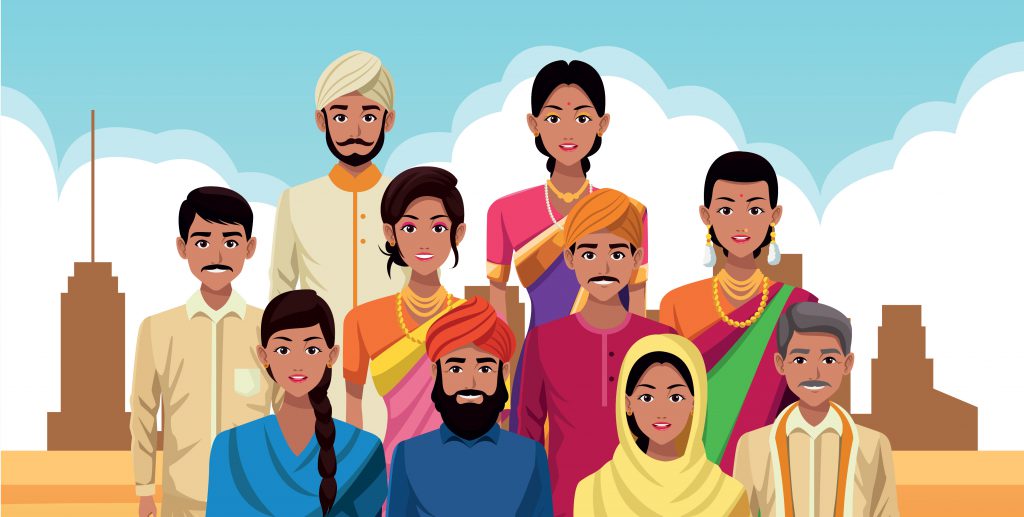September Activity – Week 1 and 2 – Teachers’ Section
Introduction:
As family members, students, members of society, and citizens of the country, we all have rights that we are entitled to exercise and duties we are expected to perform towards fellow citizens. The purpose of these rights is to ensure that each individual achieves his/her full potential. On the other hand, the purpose of the aforementioned duties is to make the individual aware of his/her responsibilities while they enjoy the rights given to them. In this session, we will not only discuss these rights and duties, but we will also discuss in depth one specific right- The right to Privacy.
You can find the list of Rights and Duties as described in the Constitution of India in the Information Handout and refer to it before starting the online class.
Right to Privacy is not limited to data. The meaning of privacy can be extended to cover other aspects including bodily integrity (being able to be secure oneself against violent assault), personal autonomy (being able to move freely from place to place), informational self-determination (the right of the individual to decide what information about himself/herself should be communicated with others and under what circumstances), protection from state surveillance (it includes direct surveillance over one’s house and also tapping one’s calls), dignity (the right of a person to be valued and respected for their own sake, and to be treated ethically), confidentiality, compelled speech, and freedom to dissent or move or think.
Executive Summary of the Activity:
[If you are viewing this page on the mobile, use the landscape mode.]
The activity is divided into the following 3 parts –
| Activity Heads | Mode | Tasks | Time Required | Responsibility |
| Section 1 - Explanation Session | Online class |
|
30 minutes | Teacher |
| Section 2 - Preparation – Research, Presentation and Group Reflections | Offline (Home assignment) |
|
2 hours | Students |
| Section 3 – Presentation and Debrief | Online class |
|
1 hour | Teacher and group leaders |
Steps for the Teacher/Facilitator
Step 2 – Discussion and debriefing
Stop the case study here and start the discussion with the students with the help of the following questions -
- What do you think is wrong with this situation?
- Do you believe that any school or college has the right to collect data from students and publish information on the public domain?
- If yes, why? And if not, why not?
- Why do you think privacy of one’s data is everyone’s right?
- What could have happened if someone had not reported the case or raised his/her voice against the same?
- What could you have faced if your data was hacked by someone if you were a student at this university?
Debrief the discussion with following pointers -
- The Constitution of India bestows on all citizens certain rights. But along with these rights, we also have certain important duties towards our family, community, and nation. It is our right to demand protection if our rights are breached but we should also be well aware of our duties to protect these rights to the best of our abilities.
- In the 21st century when so much is online, it is important to protect our data from being misused. Privacy is important for the dignity of the individual. Cyber-crimes can be stopped if we exercise our rights correctly and become alert about data privacy rights and data security issues. There is a need for people to be informed enough to report such cases and to be active enough to raise their voice against such incidents.
- In 2017, the Supreme Court of India declared that the Right to Privacy is a Fundamental Right of the citizens of India. It is a part of Article 21 of the Constitution of India. Recently, the Right to Privacy was in the news because of the questionable data sharing policy of WhatsApp and Facebook.
- Right to Privacy is not just about data. It can also extend to other aspects including bodily integrity, personal autonomy, informational self-determination, protection from state surveillance, dignity, confidentiality, compelled speech, and freedom to dissent or move or think.
Step 3 - Share the Information Handout and discuss the task in detail with students.
- Divide the class into 4-6 groups so that there are 3-4 students in each group from different standards.
- Ask the students to perform an individual activity in privacy settings.
- Step 1 - Check the privacy settings of WhatsApp, if you are using it. If you are not using WhatsApp, ask your parents/elder siblings if you can access their WhatsApp privacy settings.
- Step 2 – Follow the steps given below once you open WhatsApp-
- Click on the three dots at the top right corner in WhatsApp.
- Click on “Settings”, then click on “Account” and then click on “Privacy”.
- See the changes that you can make in your WhatsApp privacy settings.
- Step 3 – Follow similar steps for other social media apps that you use like Instagram, Facebook, etc.
- Assign a case study to each group and ask them to research more about it.
- Link the case study with the Right to Privacy.
- Explain the criteria to make a presentation:
- What is the group’s understanding of the Right to Privacy? [2 slides]
- The status of Right to Privacy in India. [2 slides]
- A summary of the assigned case study. [1 slide]
- Screenshots and links of the websites from where they have studied the case assigned to them. [2 slides]
- The group’s learnings and reflections. [2 slides]
- Ask the students to take screenshots of the privacy settings and add these screenshots to the slides. [2 slides]
- Ask the students to fill up the group reflection sheet once they are done with their presentation.
Step 4 - Closing of the activity
Close the activity with final remarks and by appreciating the efforts of all the students. Explain that the purpose of this entire activity is not just to have knowledge of rights and duties but also to understand the Right to Privacy in depth. These days while coping with the new normal, we are getting exposed to new games, websites, and social media handles to keep us engaged with the world outside. In these times, we should be particularly careful about the effects of sharing information with the outside world.
Close the session with these learnings.
Case Studies
Case 1 – Surveillance by the State
Ramesh saw a huge number of policemen around his house. The police suspected that there were some suspicious activities going on in his neighborhood. Ramesh felt threatened even though he was an innocent citizen of India now. He had a few cases against him in the past. He had served his sentence in jail and now returned to a normal life. However, the police suspect his involvement in a new case that has come up. Do you think that his residence should be putunder surveillance by the police?
Actual Case: In the Govind v. State of Madhya Pradesh Case, Mathew J. accepted the Right to Privacy as an emanation from Article 19 and 21, but the Right to Privacy is not an absolute right. Like other fundamental rights, it is also subject to restrictions to safeguard public interests. Surveillance by domiciliary visits need not always be an unreasonable encroachment on the privacy of a person owing to the character and previous actions of the person subjected to surveillance as also the objects and the limitation under which the surveillance is made. The right to privacy deals with ‘persons not the place.’
Case 2 – Personal Liberty
Suresh is a 25 year old businessman from Kolkata. He was prohibited from flying abroad because there were allegations against him that he was involved in some activities related to business fraud committed by the company. However, he believes that he must be allowed to go to London to secure an important deal for his company. Moreover, he promised to return within a week. But his request to fly was denied.. Do you think it is okay to ban someone’s right to fly abroad if he/she is facing any allegations?
Actual Case: In the Smt. Maneka Gandhi v. Union of India Case (1978), the Supreme Court’s seven Judge Bench said ‘personal liberty’ in Article 21 covers a variety of rights and some have the status of fundamental rights and have been given additional protection under Article 19. The Court thus recommended a Triple Test for any law interfering with personal liberty: (1) It must prescribe a procedure; (2) The procedure must withstand the test of one or more of the fundamental rights conferred under Article 19 which may be applicable in each situation; and (3) It must withstand test of Article 14. The law and procedure authorizing interference with personal liberty and right of privacy must also be right just and fair and not arbitrary, fanciful or oppressive.
Case 3 - Aadhar Card Data
John is a resident of Kerala. He went to buy a sim card without any document of identity proof. After purchasing a sim, he just had to give his fingerprint. All the data from his Aadhar automatically came to screen and got submitted to the sim provider. Do you think John’s sensitive information should be passed to the sim provider when he buys a sim?
Actual Case: The Supreme Court, in its final judgement on Aadhaar upheld its validity and further stated that the Aadhar Act does not violate the Right to Privacy when a person agrees to share his biometric data. However, the Supreme Court barred private companies from making use of the aadhaar card for the purpose of KYC authentication. At the same time,the apex court held that aadhaar will still be in use for various other purposes which would include PAN card and ITR filing.
Case 4 – Tapping Telephones
Ram Ratan is the CEO of a big organisation. He was talking to the Chief Finance Officer of his company over a call. They were talking about important decisions for the organisation. However, since Ram Ratan is suspected to have been involved in some suspicious activities, his calls were tapped by police officers. After a few years, Ram ratan was released by court in the case. However, he still feels that he is being tapped by the police. Do you think tapping the telephone is always wrong? What can be the exceptions to this?
Actual Case: Telephone tapping constitutes a serious invasion of an individual’s right to privacy. Is it constitutionally permissible in India? If so, within what limits and subject to what safeguards? The questions posed above have been fully considered by the Supreme Court in the People’s Union for Civil Liberties v. Union of India Case. The case was filed as a protest against the rampant instances where phones of various politicians were tapped by the CBI. The court ruled that ‘telephone conversation is an important facet of a man’s private life’. The right to hold a telephone conversation in the privacy of one’s home or office without interference can certainly be claimed as “Right to Privacy”. So, tapping of telephones is a serious invasion of privacy. This means that telephone tapping would violate the fundamental right under Article 21 unless it is permitted under the procedure established by law. The above mentioned procedure has to be “just, fair and reasonable”.
Case 5 - Dignity and Confidentiality
John and Mary are a married couple from Goa. Lately, there have been huge unrepairable differences among them. Mary used to check John’s phone in his absence. She always suspected that John was unfaithful. She even tried to damage his reputation among his colleagues by sending messages to them from his phone. John got frustrated and decided to get divorced. Do you think John’s dignity was hampered because of Mary’s actions?
Actual case: In the Rayala M. Bhuvneswari v. Nagaphomender Rayala Case, a man filed for divorce. To support his case he produced a hard disc containing the recorded conversations his wife had with certain other people in the U.S. When she denied some portions of the conversation by pointing out that it was not her voice, the Court held that the act of tapping her private conversations by the husband without her knowledge was illegal and amounted to infringement of her Right to Privacy under Article 21 of the Constitution. These talks, even if true, cannot be admissible as evidence. The wife therefore cannot be forced to undergo a voice test. The Court observed that the purity of the relation between a husband and a wife is the basis of marriage. The husband recording her telephone conversations with her friends and her parents in India without her knowledge is a clear infringement of her Right to Privacy. If the nature of the husband is such where he has no faith in his wife regarding the conversations she engages in, then the institution of marriage itself becomes redundant.
Case 6 – Be Alone
Kalia was arrested in a case related to theft. He was in jail with other mates. Since it was during the timeCOVID was spreading, he wanted to be shifted to a single cell in jail. He was suspicious that some of the jail mates might have COVID. Do you think he should have the right to be left alone?
Actual Case: In the R. Rajagopal vs. State of T.N. Case (1994), also known as the Auto Shankar Case, the Right to Privacy was held to be implicit in Article 21. The court held that “It is the right to be left alone”. A citizen has the right to safeguard the privacy of his own, his family, marriage, procreation, motherhood, childbearing and education among many other matters. In this case, the Right to Privacy of a prisoner was recognised. A prisoner had written his autobiography in jail describing the conditions prevalent there and had described the nexus between prisoners and several IAS and IPS officers. He had given the autobiography to his wife so that she could get it published in a particular magazine. However, the publication was restrained due to various concerns. The question of whether one has the right to be left alone in jail was given voice.



Responses